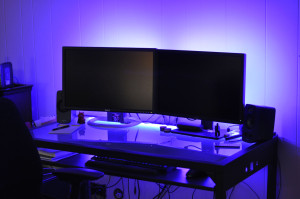I played around with one of the newer features in LightWave this week: instancing. This feature lets you load a single object and then duplicate it throughout the scene. There are multiple advantages to using instancing instead of manually loading multiple copies of an object into the scene. First, instancing uses far less memory to store the duplicated object information, which becomes very obvious if you duplicate the object hundreds of thousands of times. Second, you can use some simple rules to automatically place the objects throughout the scene, either uniformly or randomly. You can even control the random placement using a texture map.
In my initial tests, I just wanted to get instancing working using a very simple scene. Inspired by the recent news of the Kaze series, I decided to try to make a field of bamboo stalks. First, I created a single square polygon to act as a ground plane. Next, I created a very rough model of a bamboo stalk, extending vertically about 3 meters from the ground. Then I loaded those two models into Layout. Continue reading “LightWave Instancing”


